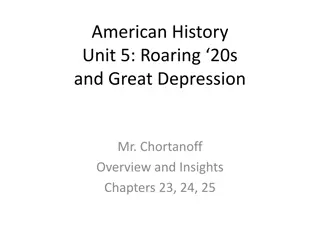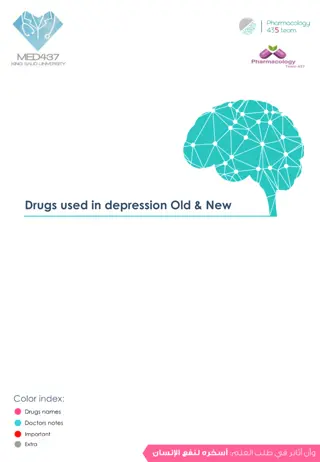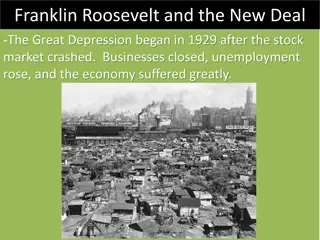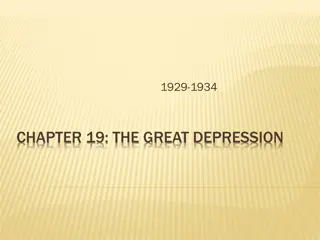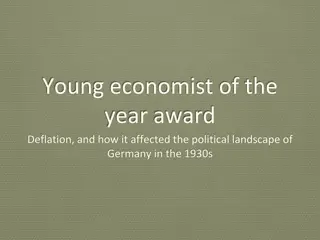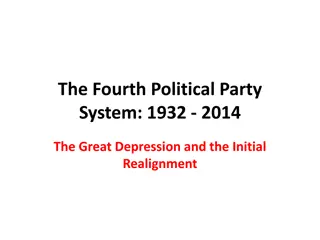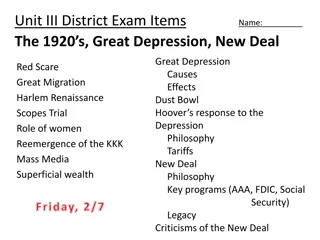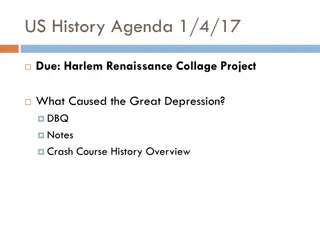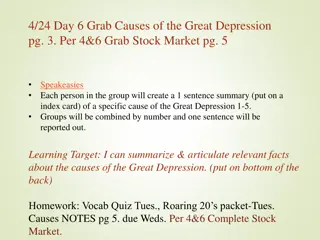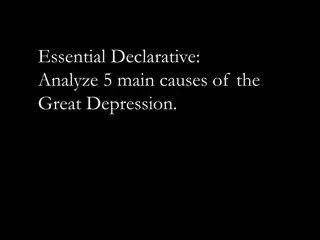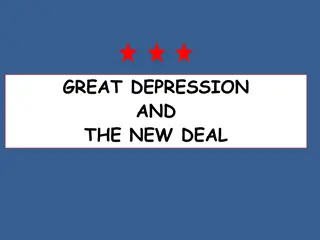Causes of the Great Depression: Economic Turmoil and Bank Failures
The Great Depression was characterized by an extraordinary reversal from prosperity to misery in the American economy. Factors such as a sharp decline in demand for goods, bank failures, and the Federal Reserve System's actions contributed to the crisis. The failure to prevent bank failures and the subsequent rise in interest rates further exacerbated the economic downturn, leading to widespread financial instability and unemployment.
Download Presentation

Please find below an Image/Link to download the presentation.
The content on the website is provided AS IS for your information and personal use only. It may not be sold, licensed, or shared on other websites without obtaining consent from the author.If you encounter any issues during the download, it is possible that the publisher has removed the file from their server.
You are allowed to download the files provided on this website for personal or commercial use, subject to the condition that they are used lawfully. All files are the property of their respective owners.
The content on the website is provided AS IS for your information and personal use only. It may not be sold, licensed, or shared on other websites without obtaining consent from the author.
E N D
Presentation Transcript
Causes of the Great Depression Unit IV
Objective & Agenda for 11/30/16 Objective Agenda Do Now SWBAT analyze how the actions and policies of the US Government contributed to the Great Depression Notes on the Causes Occupations Activity What Would You Do Discussion? BUST Video: America the Story of US Discussion Questions HW Assignment
Do Now: The American Economy went from unprecedented prosperity in the 1920s to unprecedented misery in the 1930s. It was an extraordinary reversal. Why did it occur?
What is a Business Cycle? Demand for durable goods falls Demand for investment goods falls Workers who make those goods are laid off Because these workers now have less income, they spend less- and demand falls further Demand for durable goods revives Demand for investment goods revives Workers are rehired
Except In the 1920s the demand continued to fall, business activities continued to decline and unemployment rates continued to rise. Why???
Bank Failures Federal Reserve System had been established in 1913, to prevent bank failures by lending reserves to banks that were experiencing unusually high cash withdrawals. On the eve of the Depression, the first concern of the 12 regional Federal Reserve banks should have been the overall health of the financial system. But the regional presidents, formerly commercial bankers hesitated to lend to banks in their districts that they considered unsound. As a result, many banks were allowed to fail, and the failures caused fear among account holders in sound banks, prompting them to panic and withdraw their funds.
Bank Failures continued The Federal Reserve System raised interest rates in late 1931: Discouraged business borrowing Contracted the money supply Banks kept some of their reserves in the form of bonds When interest rates rise, the prices of bonds fell Banks then held assets that have declined in value, yielding less revenue when banks sell them to raise funds to pay depositors. The problem the Federal Reserve Banks faced is that they were obliged to follow the rules of the gold standard Gold began to flow out of the US as a result of financial instability in foreign countries, and the reserve banks raised the interest rates that their member banks had to pay to borrow reserves Encouraged foreign governments and individuals to buy American bonds, rather than exchanging their dollars for American gold Raised interest rates throughout the economy, which discouraged spending by American businesses.
Occupation Card Activity Each student receives one occupation Do not reveal your occupation to anyone else Examine the following slide on US Prosperity in the 1920s
US Prosperity in the 1920s US Prosperity in the 1920s was based on the sale of house and automobiles Consumers for the first time could buy houses and cars on the installment plan- this led to job growth Jobs for workers who built homes and cars Jobs for workers who built the furniture and appliances that went into new homes Jobs for workers who produced the steel and other materials that were used to produce cars. Jobs for business firms who built new plants and bought new equipment to produce what consumers wanted Jobs for workers who built and paved roads for the new automobiles Jobs for workers in electric plants and water and sewage facilities to service the new households The prosperity of workers in all these industirres allowed them to spend a lot of money, thus providing income to other works income which they int turn spent to buy other goods and services. Economists call the spread of such new spending a multiplier effect One person s spending becomes income to another person, who in turn can spend more and add to the income of others.
US Prosperity in the 1920s Multiplier Effect in Reverse US Business activity began to slow down by the late 1920s The US economy entered a mild recession Sales of homes and cars began to fall What happened to all of the jobs that were created due to cars and homes?
Occupation Card Results: If you are asked to stand up, please remain standing for the duration of the simulation. Occupation Cards 1. If you had a job in the machinery- producing industry stand up You are now unemployed because business firms are ordering less machinery 2. If you had a job in car sales, stand up You are now unemployed because car sales are down 3. If you had a job as an autoworker, stand up You are now unemployed because factories had to fire the autoworkers because car sales went down 4. If you had a job as a steel worker, stand up You are now unemployed because the auto factories canceled orders for steel and other raw materials because car sales went down. 5. If you had a job as a construction worker, stand up You are now unemployed because the sale of houses has gone down 6. If you had a job as a furniture seller, stand up You are now unemployed because furniture sales are down 7. If you are still SEATED, you are not unemployed, but your jobs are in danger too People who are unemployed can t buy clothes If you are a clothing salesperson, please stand up You are now unemployed People who are unemployed don t eat out at restaurants If you are a restaurant worker please stand up You are now unemployed People who are unemployed cut back on expensive food items, that made higher profits for grocery stores. Grocery store owners have to reduce the number of their employees If you are a grocery store worker, please stand up You are now unemployed
Occupation Card Results continued If people start buying again, unemployment will fall, and the cycle will reverse. The downturn beginning in July 1929, was typical of a business cycle, but the recession that began in 1929 turned into a severe and long-lasting depression. Why?
Direct Causes of the Great Depression 1. Stock Market Crash of 1929: Although the workings of the New York Stock Exchange can be quite complex, one simple principle governs the price of stock. When investors believe a stock is a good value they are willing to pay more for a share and its value rises. When traders believe the value of a security will fall, they cannot sell it at as high of a price. If all investors try to sell their shares at once and no one is willing to buy, the value of the market shrinks. On October 24, 1929, "BLACK THURSDAY," this massive sell-a-thon began. By the late afternoon, wealthy financiers like J.P. Morgan pooled their resources and began to buy stocks in the hopes of reversing the trend. But the bottom fell out of the market on Tuesday, October 29. A record 16 million shares were exchanged for smaller and smaller values as the day progressed. For some stocks, no buyers could be found at any price. By the end of the day, panic had erupted, and the next few weeks continued the downward spiral. In a matter of ten short weeks the value of the entire market was cut in half. Suicide and despair swept the investing classes of America.
Direct Causes of the Great Depression 2. Bank Failures Throughout the 1930s over 9,000 banks failed. Bank deposits were uninsured and thus as banks failed people simply lost their savings. Surviving banks, unsure of the economic situation and concerned for their own survival, stopped being as willing to create new loans. This exacerbated the situation leading to less and less expenditures.
Direct Causes of the Great Depression 3. Reduction in Purchasing Across the Board With the stock market crash and the fears of further economic woes, individuals from all classes stopped purchasing items. This then led to a reduction in the number of items produced and thus a reduction in the workforce. As people lost their jobs, they were unable to keep up with paying for items they had bought through installment plans and their items were repossessed. More and more inventory began to accumulate. The unemployment rate rose above 25% which meant, of course, even less spending to help alleviate the economic situation.
Direct Causes of the Great Depression 4. American Economic Policy with Europe As businesses began failing, the government created theSmoot-Hawley Tariffin 1930 to help protect American companies. This charged a high tax for imports thereby leading to less trade between America and foreign countries along with some economic retaliation
Direct Causes of the Great Depression 5. Drought Conditions While not a direct cause of the Great Depression, the droughtthat occurred in the Mississippi Valley in 1930 was of such proportions that many could not even pay their taxes or other debts and had to sell their farms for no profit to themselves. The area was nicknamed "The Dust Bowl." This was the topic of John Steinbeck's The Grapes of Wrath.
Group Discussion: What Would You Have Done? 1.) The world financial system that emerged after World War I was based upon the gold standard. The United States and Great Britain guaranteed that they would exchange their currencies for gold at a fixed rate $20.67 for an ounce of gold, or 4.86. Other major countries agreed to exchange their currencies for gold, dollars or pounds. In 1927, several countries, most notably Germany and Austria, experienced serious bank runs. To stabilize their currencies, they exchanged their dollars and pounds for gold. The United States experienced a serious loss of gold (as did Great Britain). To encourage foreign investors to buy American investments, the Federal Reserve Banks raised interest rates. If you were an American business owner planning to build a new factory or buy new equipment, what would you have done after interest rates were increased? 2.) The Federal Reserve lowered interest rates after a time, but in 1930 and 1931, when the American economy had already taken a downturn, more bank runs occurred in many countries, and again gold flowed out of the United States. To keep gold in the United States, the Federal Reserve Banks again raised interest rates. What was the result? 3.) Now imagine that you are an American citizen with a bank account. You read the newspapers. You see that banks are collapsing in other countries and that the rate of bank failures in the United States has risen. What might you do? 4.) In 1932 Congress creates the Reconstruction Finance Corporation (RFC), which lends money to businesses that are in trouble, including banks. The law requires that the names of banks receiving loans from the RFC must be published. You read in the newspaper that the bank in which your money is deposited is receiving help from the RFC. What are you likely to do?
Group Discussion: What Would You Have Done? 1.) The world financial system that emerged after World War I was based upon the gold standard. The United States and Great Britain guaranteed that they would exchange their currencies for gold at a fixed rate $20.67 for an ounce of gold, or 4.86. Other major countries agreed to exchange their currencies for gold, dollars or pounds. In 1927, several countries, most notably Germany and Austria, experienced serious bank runs. To stabilize their currencies, they exchanged their dollars and pounds for gold. The United States experienced a serious loss of gold (as did Great Britain). To encourage foreign investors to buy American investments, the Federal Reserve Banks raised interest rates. If you were an American business owner planning to build a new factory or buy new equipment, what would you have done after interest rates were increased? Business owners were less likely to borrow to expand production; therefore, no new jobs would be created 2.) The Federal Reserve lowered interest rates after a time, but in 1930 and 1931, when the American economy had already taken a downturn, more bank runs occurred in many countries, and again gold flowed out of the United States. To keep gold in the United States, the Federal Reserve Banks again raised interest rates. What was the result? Again, business activity would be discouraged and no new jobs would be created 3.) Now imagine that you are an American citizen with a bank account. You read the newspapers. You see that banks are collapsing in other countries and that the rate of bank failures in the United States has risen. What might you do? You might want to withdraw your funds from the bank, which would discourage bank lending and increase the chances of bank failure. 4.) In 1932 Congress creates the Reconstruction Finance Corporation (RFC), which lends money to businesses that are in trouble, including banks. The law requires that the names of banks receiving loans from the RFC must be published. You read in the newspaper that the bank in which your money is deposited is receiving help from the RFC. What are you likely to do? You would probably conclude that your bank was likely to fail, and then you would withdraw your funds




